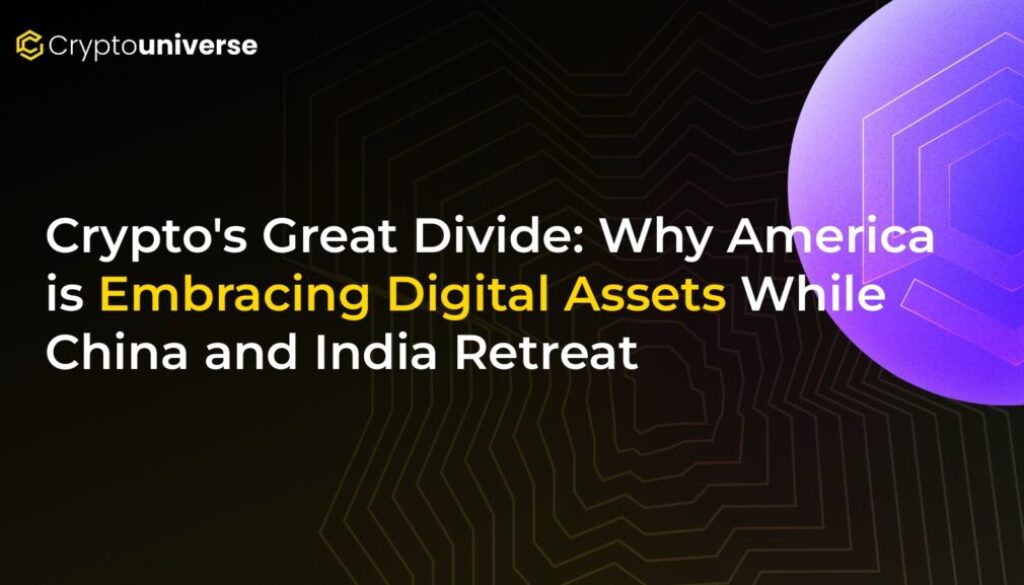Crypto’s Great Divide: Why America is Embracing Digital Assets While China and India Retreat

A New Financial World Order Emerges
The world is quietly splitting into two camps, not over territory or trade, but over the future of money itself. On one side, you have the United States and the West, where cryptocurrencies are increasingly treated as the next frontier of finance—a volatile but promising asset class. On the other, you have Asian giants China and India, who view borderless digital money with deep suspicion, leading them to impose strict controls and heavy taxes.
This growing divergence isn’t just a matter of policy; it’s a fundamental clash of economic and political philosophies. The outcome of this new “crypto war” will undoubtedly shape the global financial landscape for decades to come. Let’s break down why these powerful nations are taking such drastically different paths.
The Eastern Fortress: China and India’s Push for Control
For China and India, the rise of private cryptocurrencies like Bitcoin and Ethereum represents a threat to their economic sovereignty. Their response has been to build regulatory walls to keep them out.
China’s Great Ban
China has moved from caution to an outright prohibition. After years of tightening the screws, Beijing implemented a blanket ban on all crypto activities, including mining, trading, and even holding digital assets. This decision wasn’t made lightly and was driven by three core concerns:
- Capital Flight: The government was alarmed by the massive amounts of money leaving the country through crypto channels, with estimates suggesting over $50 billion exited in 2019-20 alone.
- Financial Stability: The wild price swings of crypto threatened the savings of ordinary citizens and could destabilize a financial system already grappling with debt.
- Political Control: Decentralized currencies directly challenge the Communist Party’s authority and its vision for a state-controlled digital future, centered around its own central bank digital currency (CBDC), the e-CNY.
India’s Fiscal Tourniquet
India hasn’t gone as far as a complete ban, but it has made the environment incredibly hostile for crypto investors. The government has imposed a punitive tax regime, including:
- A flat 30% tax on any gains from crypto assets.
- A 1% tax deducted at source (TDS) on every single trade.
The Reserve Bank of India (RBI), the country’s central bank, continues to advocate for a full ban. It fears that borderless money could undermine the Indian rupee, weaken its control over monetary policy, and open the floodgates for illicit financial flows.
The Western Gamble: America’s Open-Door Policy
Across the Pacific, the atmosphere couldn’t be more different. In the United States, crypto is not just being tolerated; it’s being integrated into the mainstream financial system. This approach is best described as regulated acceptance.
From Niche to Mainstream
Crypto adoption in the U.S. has skyrocketed, with roughly one in six American adults now owning some form of digital currency. This isn’t just a grassroots movement. Wall Street is all in, with the launch of Bitcoin ETFs (Exchange-Traded Funds) making it easier than ever for traditional investors to get exposure.
Even politicians are getting in on the action. Figures like Donald Trump are leveraging crypto’s populist appeal, with initiatives for crypto ETFs and support for dollar-pegged stablecoins. This indicates a broader view in Washington: crypto is speculative and risky, but it’s an innovation that can be managed and contained within the existing financial framework.
Why the Drastic Difference? History and Ideology
This continental divide is rooted in decades of different economic history and ideology. The West, particularly the U.S., has a long history of open markets, free-flowing capital, and experience with volatile assets. From tech stocks to cannabis, the approach has been to regulate rather than prohibit.
In contrast, countries like China and India have spent decades implementing capital controls to protect their economies and foreign exchange reserves. For them, crypto is not just another risky asset; it’s a potential backdoor that could allow wealth, taxes, and economic sovereignty to vanish in an instant with just a string of private keys. Fears of money laundering and illicit activities only reinforce this defensive stance.
The Unstable Promise of Crypto
Despite its growing adoption—now at over 560 million users worldwide—cryptocurrency remains a rollercoaster. Bitcoin has famously crashed by over 50% on multiple occasions, wiping out fortunes as quickly as it creates them.
Proponents argue that crypto offers three key benefits:
- Faster Payments: It allows for near-instant cross-border transactions.
- Financial Inclusion: It provides access to financial services for anyone with a smartphone.
- Censorship Resistance: It enables activists and dissidents to raise funds outside of state control.
However, each of these promises comes with a catch. Transaction fees can sometimes be as high as traditional bank wires, volatility can erase the savings of the most vulnerable, and the anonymity that protects activists also shields criminals and ransomware gangs.
The Final Showdown: State-Controlled Money vs. Decentralized Code
The global standoff is now entering a new phase. China is actively piloting its e-CNY, while India develops its own digital rupee. These CBDCs are the state’s answer to private crypto—offering digital efficiency with centralized control.
Meanwhile, the U.S. seems content to let private, dollar-backed stablecoins lead the way, provided they operate under some regulatory oversight. This sets the stage for a fundamental conflict: Must money be an instrument of the state, or can it be governed by code and consensus?
The architecture of crypto says yes, but its turbulent history of scams and volatility suggests the world isn’t ready to abandon traditional finance just yet. The great global crypto experiment is far from over.


